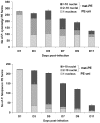Towards an in vitro model of Plasmodium hypnozoites suitable for drug discovery
- PMID: 21483865
- PMCID: PMC3069045
- DOI: 10.1371/journal.pone.0018162
Towards an in vitro model of Plasmodium hypnozoites suitable for drug discovery
Abstract
Background: Amongst the Plasmodium species in humans, only P. vivax and P. ovale produce latent hepatic stages called hypnozoites, which are responsible for malaria episodes long after a mosquito bite. Relapses contribute to increased morbidity, and complicate malaria elimination programs. A single drug effective against hypnozoites, primaquine, is available, but its deployment is curtailed by its haemolytic potential in glucose-6-phosphate dehydrogenase deficient persons. Novel compounds are thus urgently needed to replace primaquine. Discovery of compounds active against hypnozoites is restricted to the in vivo P. cynomolgi-rhesus monkey model. Slow growing hepatic parasites reminiscent of hypnozoites had been noted in cultured P. vivax-infected hepatoma cells, but similar forms are also observed in vitro by other species including P. falciparum that do not produce hypnozoites.
Methodology: P. falciparum or P. cynomolgi sporozoites were used to infect human or Macaca fascicularis primary hepatocytes, respectively. The susceptibility of the slow and normally growing hepatic forms obtained in vitro to three antimalarial drugs, one active against hepatic forms including hypnozoites and two only against the growing forms, was measured.
Results: The non-dividing slow growing P. cynomolgi hepatic forms, observed in vitro in primary hepatocytes from the natural host Macaca fascicularis, can be distinguished from similar forms seen in P. falciparum-infected human primary hepatocytes by the differential action of selected anti-malarial drugs. Whereas atovaquone and pyrimethamine are active on all the dividing hepatic forms observed, the P. cynomolgi slow growing forms are highly resistant to treatment by these drugs, but remain susceptible to primaquine.
Conclusion: Resistance of the non-dividing P. cynomolgi forms to atovaquone and pyrimethamine, which do not prevent relapses, strongly suggests that these slow growing forms are hypnozoites. This represents a first step towards the development of a practical medium-throughput in vitro screening assay for novel hypnozoiticidal drugs.
Conflict of interest statement
Figures




References
-
- Garnham PCC. Oxford: Blackwell Scientific Publications; 1966. Malaria parasites and other haemosporidia. pp. 1–1114.
-
- Coatney GR, Collins WE, Warren M, Contacos PG. Washington DC: U.S. Government Printing Office; 1971. The primate malarias. pp. 1–366.
-
- Krotoski WA. Discovery of the hypnozoite and a new theory of malarial relapse. Trans R Soc Trop Med Hyg. 1985;79:1–11. - PubMed
-
- Sutherland CJ, Tanomsing N, Nolder D, Oguike M, Jennison C, et al. Two nonrecombining sympatric forms of the human malaria parasite Plasmodium ovale occur globally. J Infect Dis. 2010;201:1544–1550. - PubMed
-
- Baird JK, Hoffman SL. Primaquine therapy for malaria. Clin Infect Dis. 2004;39:1336–1345. - PubMed
Publication types
MeSH terms
Substances
Grants and funding
LinkOut - more resources
Full Text Sources
Other Literature Sources

